Featured snippets are those eye-catching answer boxes sitting at the top of Google’s first page. They scratch the itch of searchers looking for quick answers and solutions.
Doesn’t this mean fewer clicks on your website? Sometimes.
So why should you care about featured snippet optimization? Well, snagging a featured snippet can skyrocket your visibility, send more curious clickers your way, and make your brand look like the smartest kid in class.
Did you know that 19% of search results contain featured snippets? It doesn’t seem like a lot, but if you’re targeting people who constantly ask questions, you want to ensure your answers are the first thing they see.
These snippets are the go-to source for voice search results, putting you in prime position for the future of search.
So, ready to get your content featured? Then continue reading to learn how it’s done.
What Are the Different Types of Featured Snippets?
There’s no one-size-fits-all featured snippet. Some provide short answers. Others offer charts to show, not tell.
Let’s break down the four main types you’ll encounter in search results
Paragraph Snippets
Paragraph snippets are the answering machines of the search engine results pages (SERPs). When you ask Google “What is photosynthesis?”, it may give a concise explanation right at the top of the page.
Like this one:
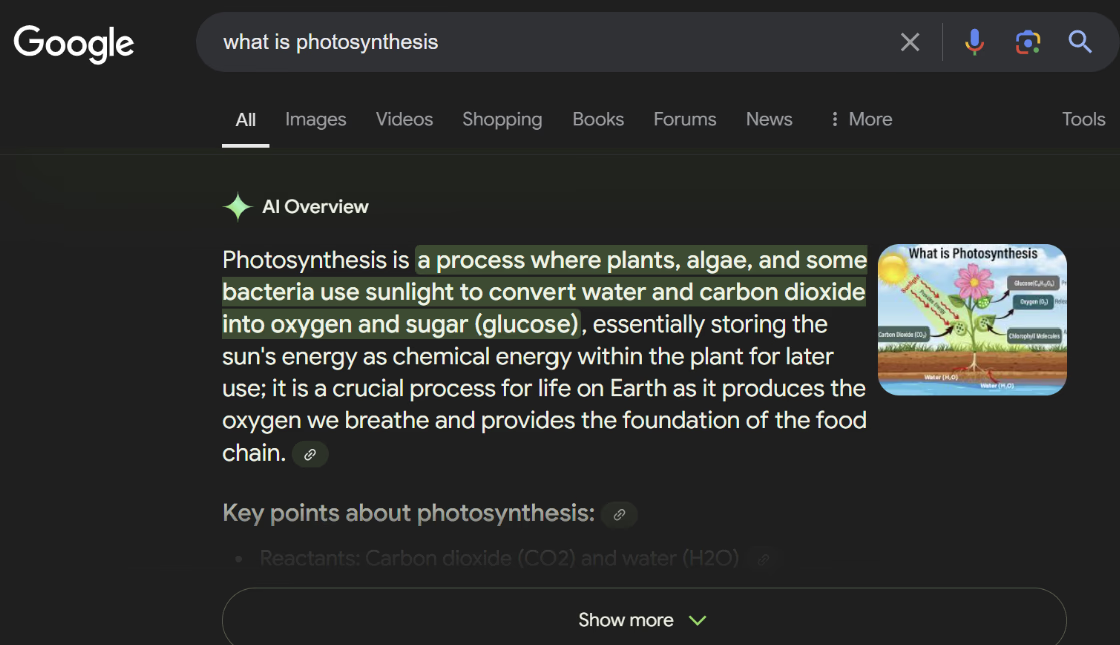
These snippets are perfect for definitions and quick explanations. To optimize for them, structure your content with clear question-and-answer formats. For example, use questions in your H2s, then immediately answer it in your first 2-3 sentences. Or add FAQ sections to your website and blog posts.
List Snippets
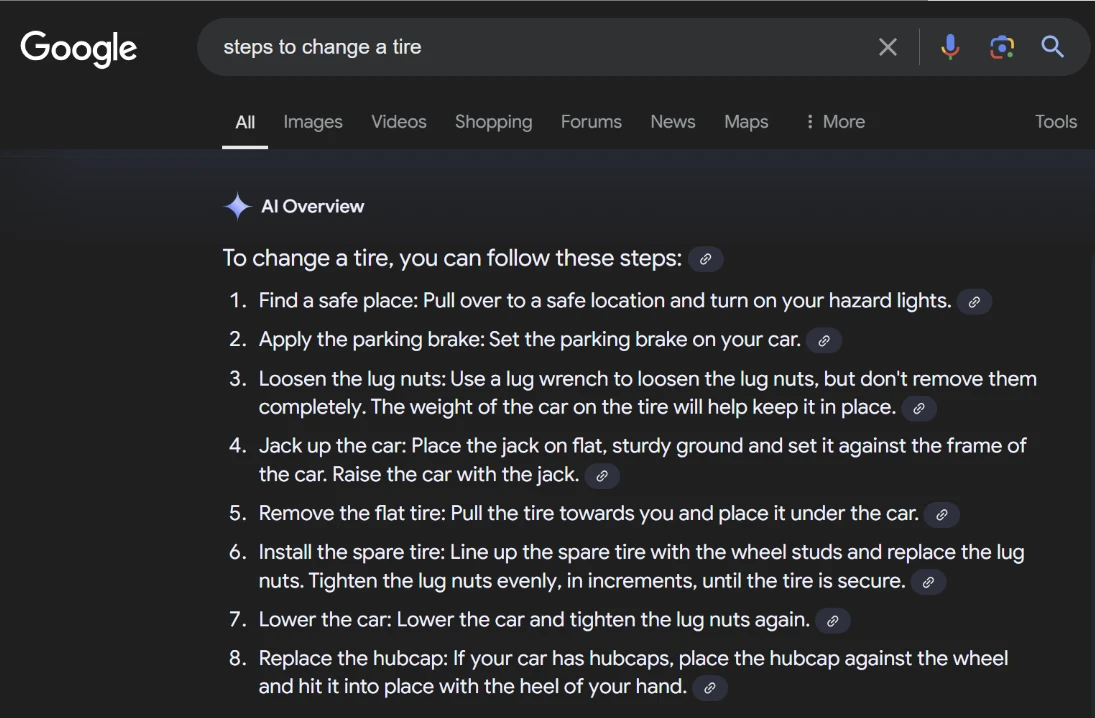
Got a process to explain or items to rank? List snippets are your best friend. They come in two flavors: ordered (numbered) and unordered (bullet points). For example, a search for “Steps to change a tire” yields a neatly ordered list.
To increase your chances of nabbing one of these, use proper HTML list formatting (ol, ul, li tags) in your content. It’s also a good idea to place a list at the top of your blog posts if your topic is in list format. For instance, “Top 10 SEO Tools in 2025,” will have numbered h2s, starting with the top tool.
Table Snippets
When data needs to be organized, table snippets shine. They’re particularly useful for comparisons, like “Smartphone features 2024”.
Here’s an example of a comparison between the Samsung S23 and S24:
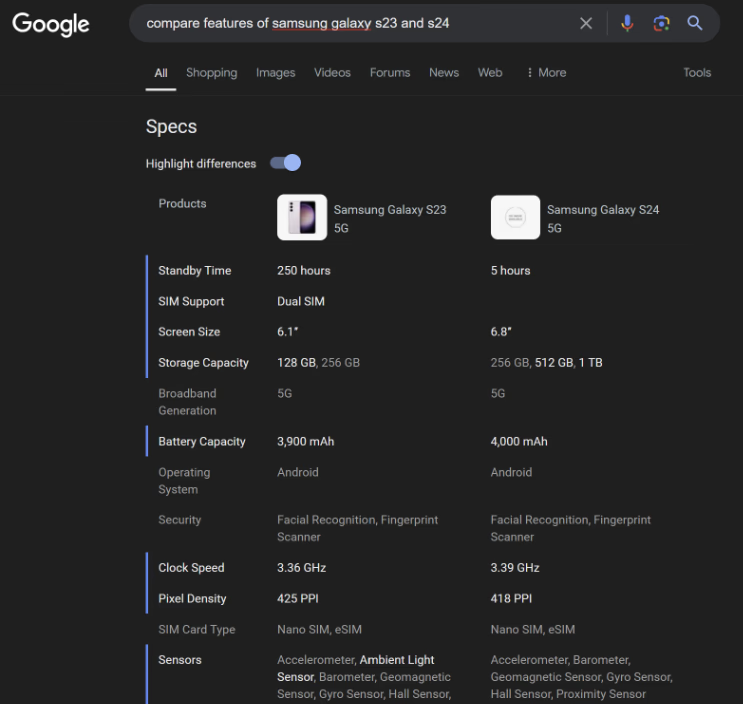
To optimize for these, create clean, well-structured HTML tables with concise data. Keep it simple and relevant to the search query.
Video Snippets
Sometimes, a picture is worth a thousand words—or in this case, a video. These snippets display a video thumbnail with a timestamp for the relevant section. For instance, a search for “How to do a pushup” may show a video snippet.
Here’s an example of a video appearing at the top of the results for the search term “how to tie a bow”:
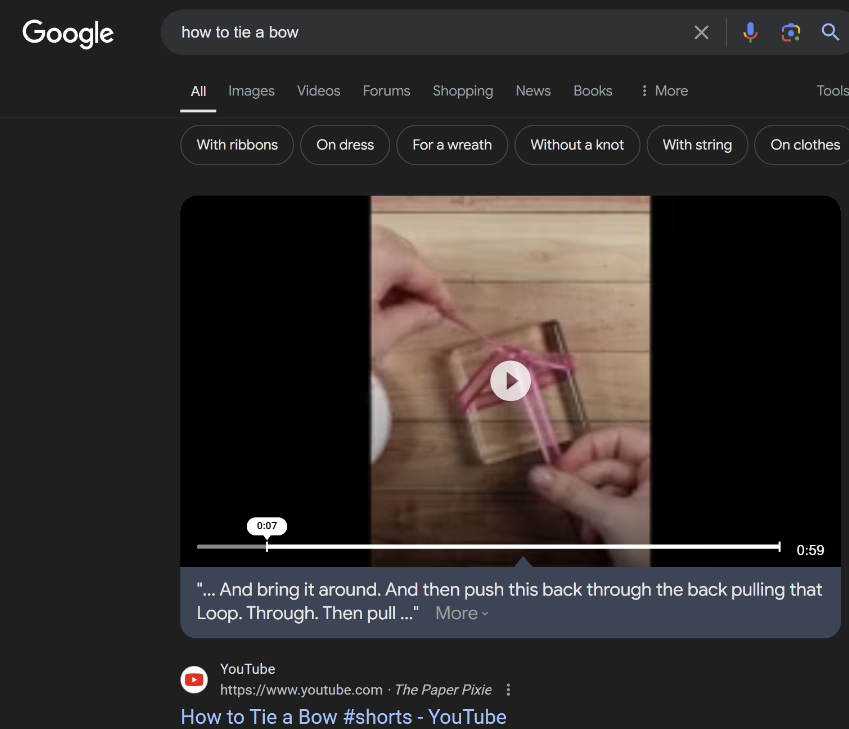
It makes sense for Google to pull video content from YouTube, since it owns the platform. So how do you optimize for video? Focus on clear titles, descriptions, and use timestamps in your video content.
Each type of snippet serves a different purpose and requires a tailored approach. By understanding these variations, you can craft your content to match the format most likely to be featured for your target keywords. Remember, the goal is to provide the most helpful, concise answer to the user’s query—in whatever form that takes.
What Are the Benefits of Featured Snippets?
Landing a featured snippet is like hitting the SEO jackpot. Here’s why you should be gunning for these prime spots.
Increased Visibility
Featured snippets are the attention-grabbers of search results. They sit at the top, above the #1 organic result. This prime real estate means more eyeballs on your content, even if you’re not the top-ranking site.
Pro tip: Track your featured snippet appearances as a key performance indicator. It’s a solid measure of your content’s visibility and relevance.
Higher Click-Through Rates
When your content is featured, it’s like Google giving you a thumbs up. Users tend to trust these highlighted answers, often leading to more clicks. But here’s the catch: you need to craft your snippet to entice users to click through for more info. So tease them with just enough information to pique their curiosity.
Improved Brand Authority
Being chosen for a featured snippet is like getting a gold star from Google. It signals to users that your content is trustworthy and authoritative. This can boost your brand’s reputation and establish you as a go-to source in your niche. The key? Focus on creating high-quality, authoritative content that truly answers user questions.
Voice Search Optimization
As voice assistants like Siri and Alexa become more popular, featured snippets are gaining even more importance. Many voice search results are pulled directly from these snippets. By optimizing for featured snippets, you’re also positioning your content for the growing voice search market. Focus on natural language and question-based queries to align with how people actually speak.
For example, if you’re a small business owner who runs a plumbing business, you might want to optimize for ‘plumbing services in [your city]’ or ‘find a plumbing service near me.’
By targeting featured snippets, you’re not just improving your SEO—you’re enhancing your overall digital presence and user experience. It’s a win-win strategy that can set you apart in a crowded online space.
How to Optimize for Featured Snippets
Ready to claim your spot in the featured snippet limelight? Here’s your game plan:
Identify Opportunities
First, you need to know where to aim. Use keyword research tools like Semrush’s Featured Snippet report to uncover queries that trigger snippets in your niche. Don’t just focus on high-volume keywords—long-tail queries often present easier wins.
Next, spy on your competitors. Tools like Ahrefs can show you which snippets they’re winning. Analyze their content structure and format—what are they doing right? This intel is gold for your optimization strategy.
Create Snippet-Friendly Content
Now, it’s time to craft content that Google loves to feature:
- Answer questions concisely: Aim for clear, direct answers in about 40-60 words. For example: “Photosynthesis is the process by which plants convert sunlight into energy. They use chlorophyll to absorb light, which then triggers a chemical reaction that produces glucose from carbon dioxide and water.”
- Use clear headings: Structure your content with question-based H2 and H3 tags. This helps Google understand your content’s organization.
- Implement structured data: Use schema markup to give Google more context about your content. The FAQ schema is particularly useful for snippet optimization.
Format for Success
The way you present your content also matters. Here’s what to do:
- Embrace lists: Use bullet points and numbered lists for processes or collections of items. Start each point with an action verb for added clarity.
- Create tables: For comparisons or data presentations, well-structured HTML tables are your best bet. Keep them concise and relevant.
- Optimize images: Don’t forget about visual snippets. Use descriptive, keyword-rich alt text for important images.
Focus on User Intent
At the end of the day, it’s all about giving users what they want. So, make sure to:
- Address common questions: Use tools like AnswerThePublic to find what people are asking in your niche.
- Provide comprehensive answers: While your snippet should be concise, the rest of your content should dive deeper. This encourages users to click through for more information.
Remember, optimizing for featured snippets is an ongoing process. Keep refining your approach based on what works, and stay alert for new opportunities. With persistence and smart strategy, you’ll be snippet-worthy in no time.
Best Practices for Featured Snippet Optimization
Alright, you’ve got the basics down. Now let’s dive into some pro-level tactics to really boost your snippet game.
Keep Answers Concise
When it comes to paragraph snippets, brevity is your best friend. Aim for 40-60 words that pack a punch. Here’s a trick: front-load your answer with the most crucial information. Google loves a good topic sentence, so make yours count.
Example:
“A solar eclipse occurs when the moon passes between the Earth and the sun, temporarily blocking sunlight. This celestial event can be partial, total, or annular, depending on the moon’s position relative to Earth.”
Use Question-Based Headers
Think like your audience. What are they asking? Use these questions as your H2 and H3 headers. It’s like laying out a welcome mat for both users and Google’s algorithms.
Pro tip: Tools like AnswerThePublic uncover common questions in your niche. Use these insights to structure your content.
Implement FAQ Schema Markup
Speaking Google’s language can give you an edge. FAQ schema markup explicitly defines questions and answers on your page. It’s like giving Google a roadmap to your content.
After implementation, always double-check your work with Google’s Structured Data Testing Tool. It’s better to catch errors early than wonder why you’re not getting featured.
Keep Content Fresh
Google has a soft spot for up-to-date information. Set a regular schedule for content audits and updates. This doesn’t mean rewriting everything–sometimes, a quick fact-check and date update is all you need.
Example: If you have a “Best Smartphones of 2024” article, make sure you’re updating it with the latest models and removing outdated information.
Optimize for Different Snippet Types
Don’t put all your eggs in one basket. Diversify your content to target various snippet types:
- For list snippets: Use clear, step-by-step instructions or bulleted lists.
- For table snippets: Present comparative data in well-structured HTML tables.
- For video snippets: Use clear titles, descriptions, and timestamps in your video content.
Provide the most helpful, concise answer to the user’s query to increase your odds of being featured. By following these best practices, you’re not just optimizing for snippets–you’re creating better, more user-focused content overall. And that’s a win-win in anyone’s book.
Examples of Effective Featured Snippet Optimization
Let’s dive into some hypothetical examples to see these optimization techniques in action. These scenarios will help you visualize how to apply snippet optimization strategies to different types of content.
Recipe Blog: “How to Make Sourdough Bread”
Imagine a food blog aiming to snag a featured snippet for the query “how to make sourdough bread.” Here’s how they might optimize their content:
- Clear step-by-step instructions:
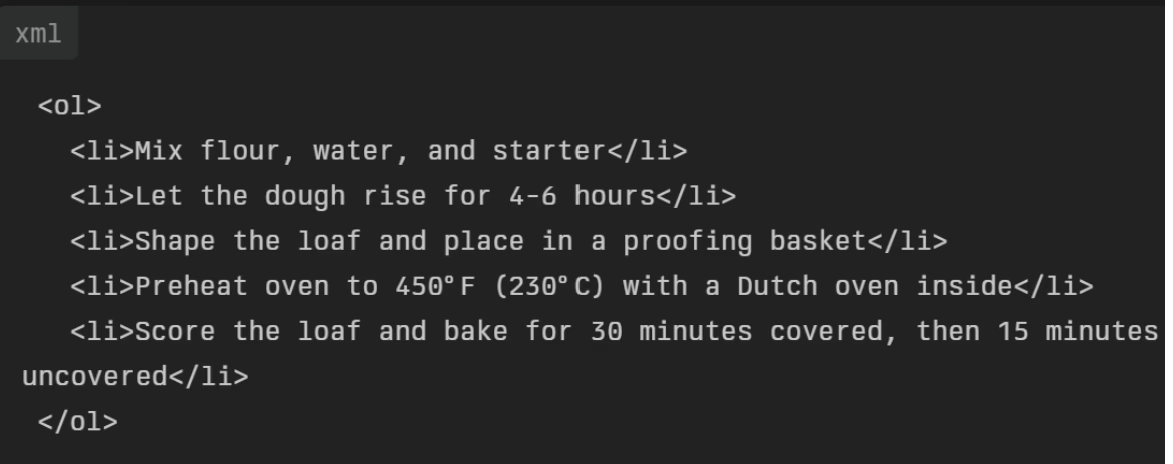
This numbered list is perfect for a list snippet, providing a clear overview of the process.
-
Concise ingredient list:
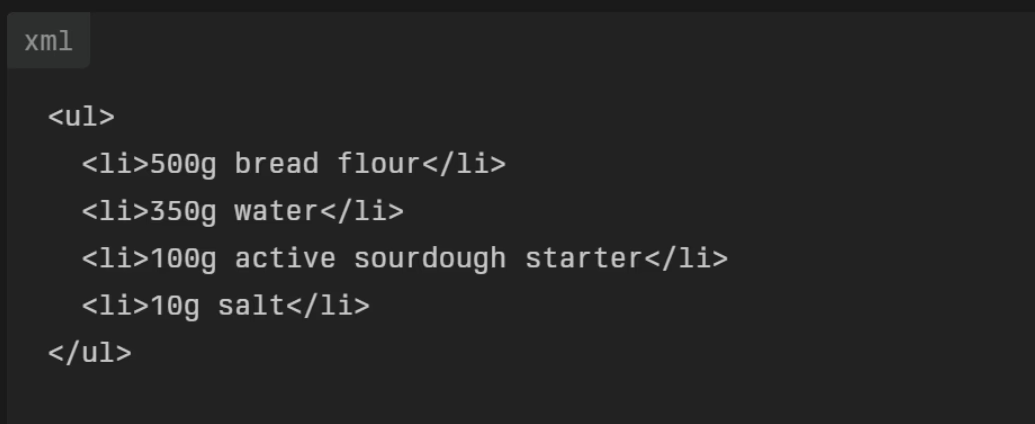
A bulleted list of ingredients helps users quickly assess what they need.
-
Relevant image with descriptive alt text:

This optimized image could appear in image-based snippets, enhancing the visual appeal of the content.
Tech Review Site: “Best Smartphones 2024”
For a tech site targeting the query “best smartphones 2024,” the optimization might look like this:
-
Comparison table with key features:
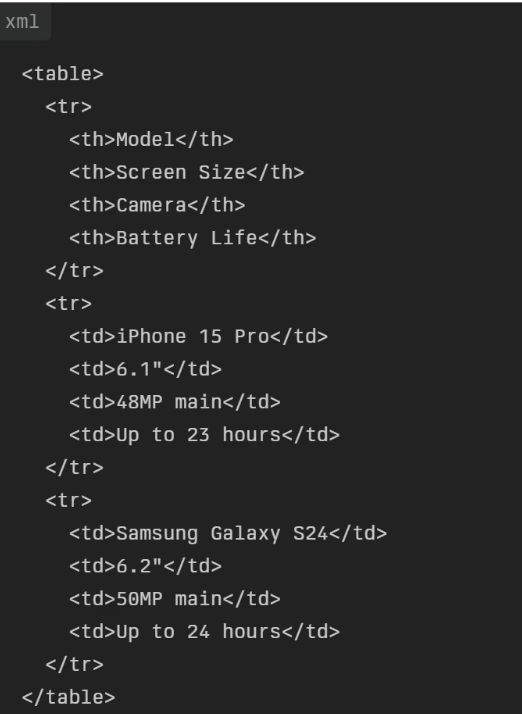
This table is primed for a table snippet, offering a quick comparison of top models.
-
Brief summaries of top picks:
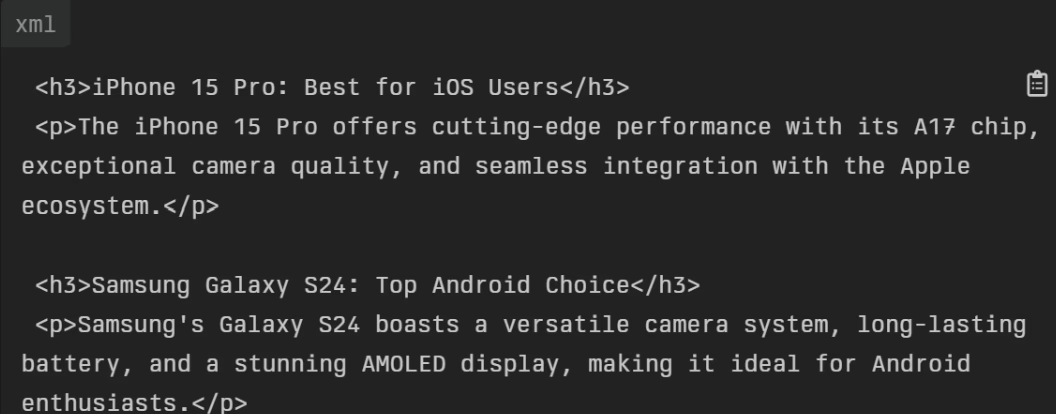
These concise paragraphs provide quick overviews that could be featured in paragraph snippets.
-
Structured data implementation:
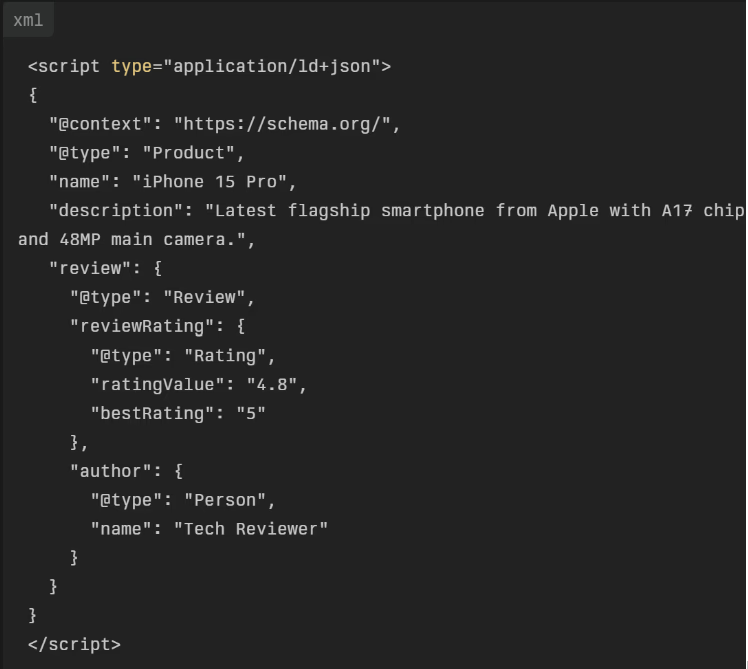
This Product schema markup enhances the chances of rich results in search, potentially leading to featured snippets.
By structuring content in these ways, these hypothetical sites increase their chances of securing featured snippets.
What Are Common Challenges and Considerations?
While featured snippets can be a game-changer for your SEO strategy, they’re not without their hurdles. Let’s dive into some of the challenges you may face along the way:
The Zero-Click Conundrum
Here’s a head-scratcher: sometimes, featured snippets can lead to zero-click searches. Users get their answer right in the search results and bounce without visiting your site. Talk about a double-edged sword!
Solution: Craft your snippets to tease, not tell all. Give enough info to establish authority, but leave users wanting more. For example:
“Sourdough bread is made through a fermentation process that typically takes 12-24 hours. The exact time depends on factors like temperature and starter strength. For the perfect loaf, you’ll need to master the following steps…”
This snippet answers the basic question but hints at more detailed information on your site.
The Itching-to-Switch Algorithm
Just when you think you’ve got it down pat, Google changes the rules. Search algorithms are as fickle as fashion trends, so what works today might not work tomorrow.
Solution: Stay on your toes. Keep up with SEO news and be ready to adapt. Diversify your optimization strategies so you’re not putting all your eggs in one algorithmic basket. And remember, quality content never goes out of style.
Fierce Competition
In popular niches, the battle for featured snippets can be as intense as a Game of Thrones finale. Everyone wants that top spot, and only one can win.
Pro tip: Look for less competitive long-tail keywords. Instead of targeting “best smartphones,” try “best waterproof smartphones for underwater photography.” It’s specific, has clear user intent, and likely faces less competition.
Maintaining Your Snippet Position
Winning a featured snippet is one thing—keeping it is another. Your coveted position can vanish faster than free samples at a grocery store.
But there’s a way around it: Regular content audits. Set a schedule to review and refresh your top-performing pages. Update statistics, add new information, and ensure your content remains the most relevant and comprehensive answer to the query.
Featured snippet optimization is a marathon, not a sprint. It requires patience, persistence, and a willingness to adapt. But with the right approach, the challenges become opportunities to refine your strategy and stand out.
Start Snipping Your Content with Snippets In Mind
Featured snippets are the golden tickets of the search world, offering a fast track to visibility and authority. By understanding the types of snippets, optimizing your content strategically, and staying on top of best practices, you can position your site to claim these coveted spots.
But, snippet optimization isn’t a one-and-done deal. It’s an ongoing process that requires vigilance, adaptability, and a keen eye for user intent. The challenges are real, but so are the rewards.
Now, it’s time to put this knowledge into action. Start by analyzing your existing content for snippet opportunities. Which of your pages could be restructured to better answer common queries? Use the tools we’ve discussed to identify high-potential keywords and study your competitors’ winning strategies.
Begin implementing these optimization techniques gradually, and don’t forget to track your results. Every snippet won is a victory, and every loss is a learning opportunity.
